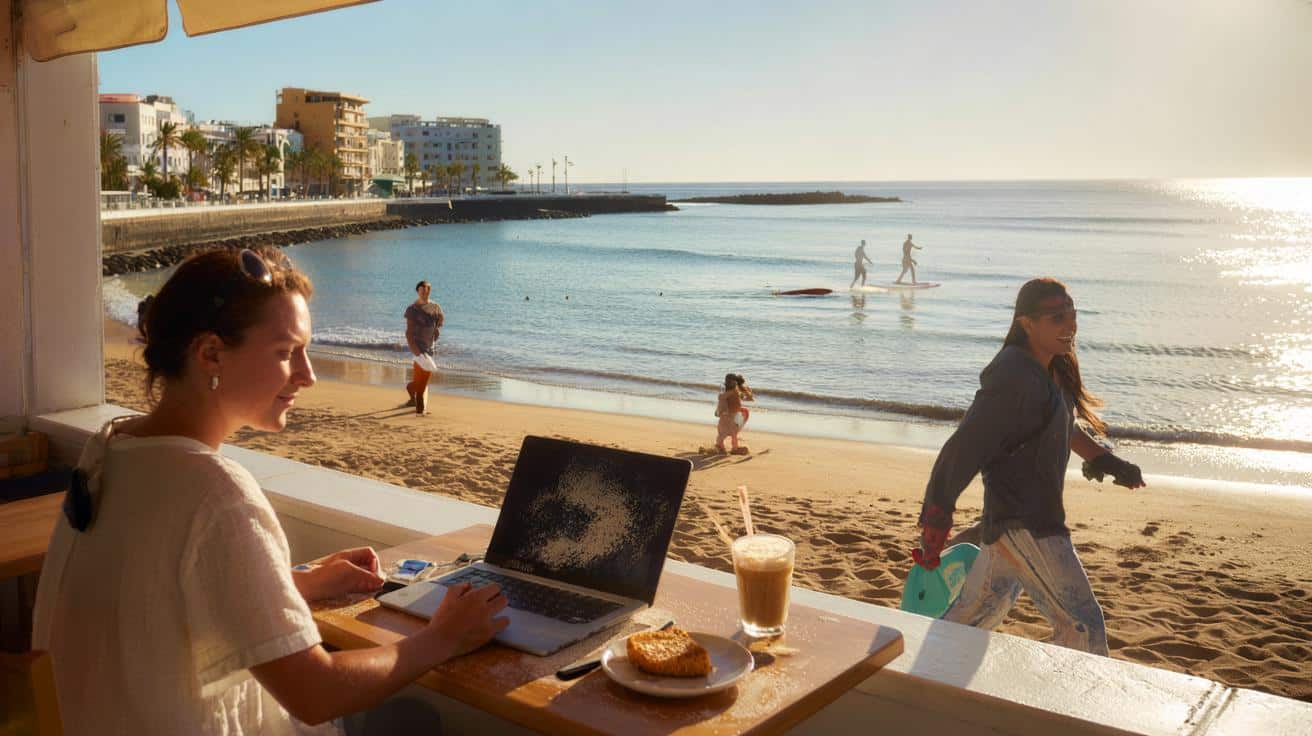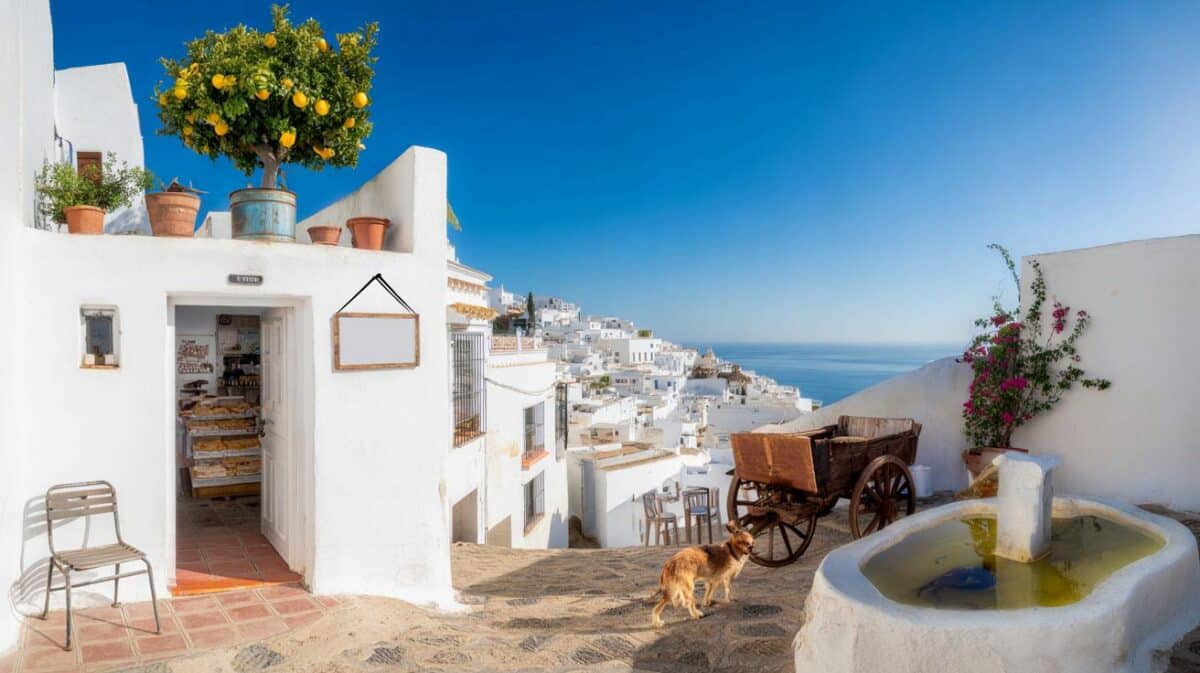One of them sits on an Atlantic curve of gold sand and slow mornings, where the sun graces faces even in February. People come for a week, lose track of their inbox, and stay for a season.
The first light slides over the promenade at Las Canteras and catches on salt-spray, a soft halo on joggers and paddle boarders. A barista bumps old vinyl inside a café the size of a garage, pulling cortados as a surfer pads in with wet hair and a grin. Someone in a linen shirt taps a laptop with sandy fingers, a spreadsheet open next to a half-eaten tostada.
*The light feels unearned in January.* Strollers drift by, nobody sprinting, nobody checking the time. A child squeals at the edge of the shore, then the tide hushes it away. By nine, the only meeting that matters is where the swell breaks on the reef. The rest can wait. Watch what happens.
Las Palmas, a city where emails learn patience
Las Palmas de Gran Canaria looks like summer that forgot to end. Trade winds temper the heat, so afternoons settle in the low twenties even when Europe shivers. The sea sits close to everything, a blue companion shadowing your day.
On the promenade, conversations run on sea-time. The pace slips into your bones. And that’s where the magic lives: the city puts your nervous system on mute. **Las Canteras** becomes your clock.
Meet Alex, a designer from Manchester who came for a fortnight and rented a room for the winter. His team is scattered across London, Lisbon, and Chicago, so they switched to asynchronous updates. He swims at eight, writes at ten, and posts a single end-of-day note. Once a week he jumps on a call when the sun dips and the wind calms. The rest is focus. The only thing that pings is the microwave heating yesterday’s mojo sauce.
Four and a half hours from rain to rays, with shoes that never quite dry. Flights land into a city of 380,000 that behaves like a seaside village before noon and a Spanish capital after dark. There are tiny bakeries in Guanarteme and wine bars in Vegueta, both a walk away. And there’s a secret life happening behind every balcony: work, done quietly.
Why does it feel like endless summer here? The island’s latitude and the Atlantic cool the edges off the year, so the air rarely bites or burns. That steadiness makes routines painless. You don’t negotiate with the weather; you negotiate with your energy.
Spanish rhythms help. Lunch stretches. People talk standing up, staring at waves, not screens. The promenade acts like a moving desk—ideas arrive while you walk, and the sea edits them. For UK workers, the time zone is kind. You’re one hour behind London, which means mornings can be yours and the afternoon belongs to your team. “No meetings” isn’t a slogan. It’s a boundary that sticks because outside is too good to waste.
The art of living a meeting-free day by the sea
Start by blocking mornings for deep work. Not an app. A rule. Use a single line in your status—“Heads down till 1pm, updates doc here”—and stick to it. Then step outside for a short walk on the promenade before you open anything with tabs. Your brain will thank you.
Write like a person, not a memo. Short updates, one decision per paragraph, links to context. Record a two-minute video when text would turn into a novel. Set two weekly windows for calls, back-to-back, and let them fill or not. The city rewards rhythm. So give it one.
Common traps? Saying yes to everything social your first week. The island is friendly, and you’ll get ten invites by Tuesday. Take half. Overcommitting means your “no meetings” day becomes “four coffees and a headache.” Another trap is pretending the wind isn’t a thing; it shifts across the beach and your ideal swim time moves with it. We’ve all had that moment when you chase the perfect day and miss the good one right in front of you. Let’s be honest: nobody really does that every day.
Your toolkit can be light. A good pair of walking shoes, a portable keyboard if you like writing by the water, and a plan for the mid-afternoon lull. That’s when the sun gets bossy and your brain fades. Move, swim, nap, or take the long route to the fruit market. Then slide back into focus with a clear, small task. One win begets another.
What do locals think of all these laptop people by the sea? Opinions are mixed, but often kind. A café owner near the reef put it best.
“Work if you must,” she said, stacking cups, “but don’t stare at your life from the wrong side of the glass.”
- Neighbourhoods to feel the rhythm: Guanarteme for surf and cafés; Vegueta for cobbles, galleries, and twilight wine.
- When the sea behaves: Early mornings for gentle water; late afternoons for glow and long swims by the reef.
- Where to plug in: Quiet cafés a block off the beach; small coworking rooms with windows that open.
- Budget sanity: Daily coffee and tostada can be modest; rent rises near the sand, so widen your radius by three streets.
- Two smart rituals: A midday walk without your phone, and a single-page weekly plan sent every Friday.
What lingers after the sun goes down
The first thing you notice when you leave is the silence of your calendar. You feel suspicious of it, then you miss it. Friends back home ask what you did all winter, and you say, “Worked a lot, swam more,” and it sounds small until you hear yourself say it twice.
There’s a tenderness to life when the weather stops being an argument. You cook more. You call your mum. You read sitting on steps. The world narrows into a few honest habits that repeat until they feel like yours.
The city teaches you what not to do, too. Don’t rush the tide. Don’t outrun the wind. Don’t schedule away your best hours. That’s the real luxury here: not the sun or the sea, but the space between pings, the way strangers wave in the same place every day, the idea that you can build a life in the gaps. Maybe that’s what an endless summer really is.
| Point clé | Détail | Intérêt pour le lecteur |
|---|---|---|
| Climate that behaves | Stable 20–25°C most of the year with trade winds and bright Atlantic light | Plan routines without weather drama and keep energy steady |
| Promenade productivity | Walk-and-think culture along **Las Canteras**, cafés a minute from the water | Shift from meetings to movement and better ideas |
| Time-zone sweet spot | One hour behind the UK, close to Europe, workable overlap with the Americas | Protect mornings for deep work and keep teams connected |
FAQ :
- Where exactly is this “endless summer” town?Las Palmas de Gran Canaria sits in Spain’s Canary Islands, off the northwest coast of Africa, in the Atlantic. It’s a European city with a beach for a front garden.
- Is it genuinely warm all year?Expect mild winters and warm, breezy summers. Many days hover in the low twenties, with cool evenings and a forgiving sea. Pack a light jumper for nights and terraces.
- Can I work UK hours from there?Yes. You’re one hour behind London time, so you can keep your usual schedule or take slow mornings and shift calls to the afternoon. Most remote teams find the overlap easy.
- What months feel best?January to April if you crave winter sun and calm seas by the reef. May and June for longer days and space. September and October bring dreamy sunsets and a softer breeze.
- Do I need a visa for a longer stay?UK travellers can spend up to 90 days in any 180-day period in the Schengen area. EU citizens can stay and work freely. For longer stays, check current rules before you book.










This reads like a permission slip to fix my calender. Blocking mornings, two call windows—chef’s kiss. Las Canteras as a clock is a gorgeous idea.